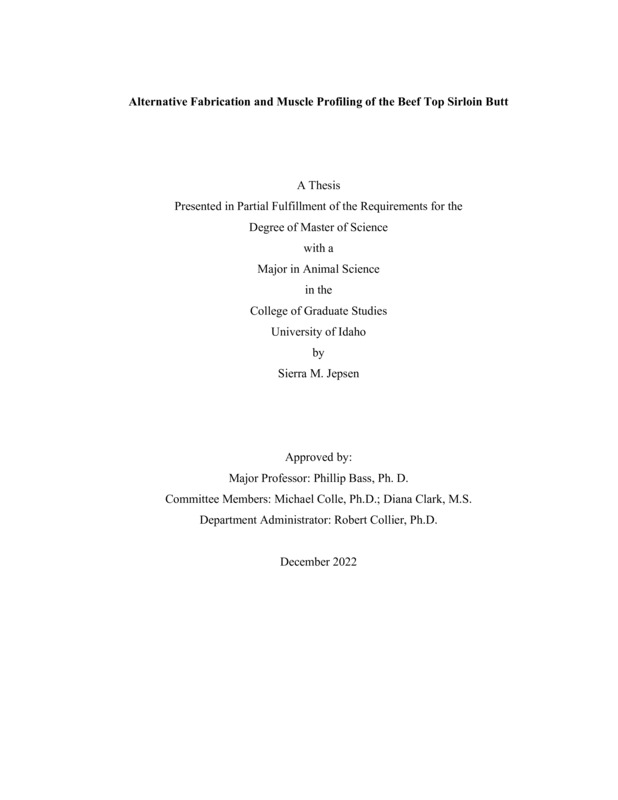Alternative fabrication and muscle profiling of the beef top sirloin butt
Jepsen, Sierra M. (2022-12). Alternative fabrication and muscle profiling of the beef top sirloin butt. Theses and Dissertations Collection, University of Idaho Library Digital Collections. https://www.lib.uidaho.edu/digital/etd/items/jepsen_idaho_0089n_12471.html
- Title:
- Alternative fabrication and muscle profiling of the beef top sirloin butt
- Author:
- Jepsen, Sierra M
- Date:
- 2022-12
- Keywords:
- beef Biceps femoris Gluteus accessorius Gluteus medius muscle profiling top sirloin
- Program:
- Animal, Vet & Food Sciences
- Subject Category:
- Animal sciences
- Abstract:
-
Muscle profiling improves value and optimization of beef carcasses by expanding knowledge of physical, compositional, and marketable attributes of single-muscle cuts. Traditional fabrication of the beef top sirloin butt (NAMI #184) incorporates several muscles into a single steak, leading to tenderness variation and inconsistent portion sizing compared to steaks consisting of a single muscle. The objective of the study was to isolate and discern yield and intrinsic characteristics of individual muscles and muscle subunits of top sirloin butts (N = 70) collected from carcasses ranging in quality grade (QG: USDA Select and Top Choice), hot carcass weight (HCW: light ≤ 362 kg, medium = 363 - 453 kg, heavy ≥ 454 kg), and ribeye area (REA: small ≤ 27.8 cm2, medium = 27.9 - 40.6 cm2, large ≥ 40.7 cm2). Weight and dimension (length, width, height) were obtained for the whole top sirloin, Biceps femoris (BF), Gluteus accessorius (GA), and Gluteus medius [whole, dorsal (GMD), ventral (GMV)]. From each muscle and muscle subunit, a 2.54cm steak was obtained and analyzed for fluid loss, color, pH, and tenderness. Results show USDA Select carcasses yielded heavier top sirloin butts than Top Choice carcasses (P = 0.001), with Select products having less yield loss compared to Top Choice (35.5% vs. 41.4%). Weights of top sirloin butts increased as HCW increased from light to heavy (P < 0.001), and REA increased from small to large (P < 0.001). For all individual muscles, weights were found to be heavier in Select carcasses compared to Top Choice: BF (P < 0.001), GA (P < 0.001), GM whole (P < 0.001). Three-way interactions between QG, HCW, and REA were observed for weight of the GM whole (P = 0.036), width of GMD (P = 0.004), and length of GMV (P = 0.039), confirming the GM muscle was the primary source of muscle size variation in the beef top sirloin butt. For individual muscles (BF, GA, GMD, GMV), USDA Top Choice muscles were more tender than Select (P < 0.001). Objective tenderness, measured using averaged Warner-Bratzler shear force values, were the lowest for the GA and BF (P < 0.001) and were statistically different than the GMD and GMV. A two-way interaction for a* color score (P = 0.046) between individual sirloin muscle and quality grade indicated BF and GA muscles within either quality grade were more red than GM muscles, and USDA Select GM muscles were redder than Top Choice GM muscles. The BF presented the lowest L* value (P < 0.001), thus the darkest color. The GA reported the highest pH value (P < 0.001), with the lowest percentage of fluid loss (P < 0.001). Gluteus medius muscle subunits manifested the highest shear force values (P < 0.001), lightest color (P < 0.001), lowest pH (P < 0.001), and most fluid loss (P < 0.001). All four top sirloin muscles and muscle subunits averaged peak shear force values below 3.9 kg, thus, all within the threshold for USDA “very tender.” The resulting muscle profiling data will benefit in identifying new beef value cuts from the top sirloin butt and assessing acceptability of sirloin cuts for further retail and foodservice merchandising opportunities.
- Description:
- masters, M.S., Animal, Vet & Food Sciences -- University of Idaho - College of Graduate Studies, 2022-12
- Major Professor:
- Bass, Phillip D
- Committee:
- Colle, Michael J; Clark, Diana; Collier, Robert
- Defense Date:
- 2022-12
- Identifier:
- Jepsen_idaho_0089N_12471
- Type:
- Text
- Format Original:
- Format:
- application/pdf
- Rights:
- In Copyright - Educational Use Permitted. For more information, please contact University of Idaho Library Special Collections and Archives Department at libspec@uidaho.edu.
- Standardized Rights:
- http://rightsstatements.org/vocab/InC-EDU/1.0/

